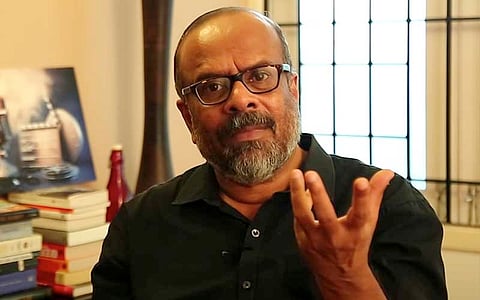
- Reviews
- Power List 2024
- Cannes 2024
- In-Depth Stories
- Web Stories
- News
- FC Lists
- Interviews
- Features
- FC SpecialsFC Specials

Sab John, known for writing Guna (1991), Chanakyan (1989) and Sillunu Oru Kadhal (2006), speaks about the five basic elements of screenwriting. "The five basics are what I always think and realise that people should know about the elements of screenplay. People always ask me: 'Is script and screenplay the same?' Story and screenplay are two different things. A young guy who doesn't know about these five elements, will say 'The first scene is' (does hand action) and move ahead. I would immediately ask if he is starting with the scene or the story."
Stories have two concepts. One, story is an emotion. Movies are actually stories. Screenplays aren't stories. Screenplays are just structures. Once we try to write a story, we should know more about emotions, otherwise you won't be able to write them. Second, Robert McKee has said: "Somebody wants something, but has difficulty getting it". This is what I mean by story. It's about the emotional package which is there while you narrate something. Narration is a different process. Normally, when you come after a movie, let us say Dangal (2016), you can say the story in just one line: It's about a man accomplishing a feat he couldn't, through his daughters. This is actually the story.
There is this great question when it comes to writers — which should come first, the story or the character? The chicken or the egg? This is a perennial question. And I think it was proven that the chicken came first, biologically and logically. Here, the story and the character have to grow together. They are complementary. When the character arrives, the character has to contribute to a story, and the story has to create characters. By the time the characters come in, we always say the story starts walking. The story has legs when you come up with characters. In Dangal again, when you think of the story, the father who pursues his goal comes to mind; so do the daughters who are being trained by the father to achieve his goal. Basically, the story is revealed through characters. There is another great example. Aristotle always believed that "Characters are just ploys inside a story". When it comes to Lajos N Egri who contradicted Aristotle in the art of dramatic writing, he said, "What is honey? Honey doesn't exist without bees. If there are no characters, no story will exist". So these are the two components of the track that American cinema and European cinema, especially French cinema, take. European cinema actually takes after characters, and finds the story in their journey. On the other hand, American cinema is more formalic/formulaic and places characters inside a story. These are the two basic differences.
Dialogue has three basic uses in a screenplay. One, it reveals character. Two, it advances the story. And the most crucial use, as I see, is that dialogues actually take off the visual if it is not necessary, or if it is not pragmatic. If, in a scene, you cannot show a car accident, you can use a dialogue to describe it as an accident.
The fourth element is what I consider the most important. A screenplay is its structure. There are linear and non-linear structures. There are different aspects. Structure is storytelling. A good story well told is structure. There are two elements when it comes to story and storytelling. All stories are linear by default. Stories are nothing but extensions of life, and life cannot start from your marriage. Life cannot start from death. Life can start only with birth. The linear order can be pursued when it comes to story, but storytelling can differentiate it. The storytelling can start from the end. There is a movie called Irréversible (2002), which starts from the end and moves toward the beginning. Or, even Memento (2000). Dangal is again a very linear kind of an emotional journey that works out. Basically, the master screenwriter has to work on how best the story can be told.
In cinema, you cannot avoid the fifth element, visuals. I would say the spectacle of this whole thing is by visuals. When it comes to screenwriting, you have to create the imagery. If these five elements are coordinated well, and assessed well, you are there to be a screenwriter.